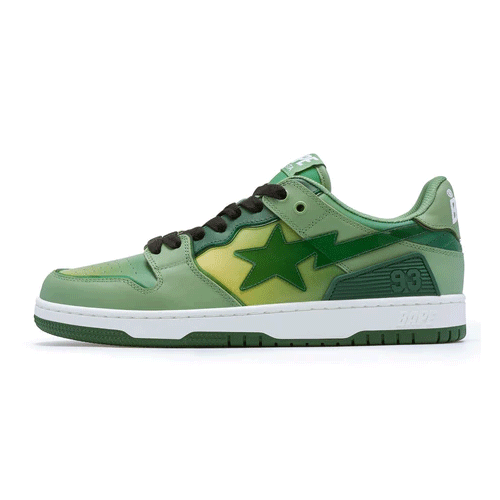In the ever-evolving landscape of fashion and sneaker culture, few sneakers have held their ground quite like the Bapesta. Originating from the trailblazing Japanese streetwear brand A Bathing Ape (BAPE), the Bapesta is not just a sneaker—it's a cultural statement. With its bold designs, unmistakable star logo, and rich history, the Bapesta has earned its place among the most influential sneakers in fashion history.
Whether you're a streetwear aficionado or just discovering the world of sneakers, the Bapesta is a name you need to know.
The Origins of Bapesta: A Bold Beginning
To understand the Bapesta, you first have to understand A Bathing Ape, founded by Nigo in 1993 in the heart of Harajuku, Tokyo. Inspired by pop culture, American hip-hop, and Japanese street style, Nigo created a brand that was unapologetically loud and unforgettably unique.
In 2000, Nigo introduced the Bapesta—a sneaker clearly influenced by the Nike Air Force 1, but with a twist. Instead of the traditional Swoosh, the Bapesta featured a lightning bolt star motif, known as the "STA," and boasted a shiny patent leather upper that instantly caught the eye.
The Air Force 1 Comparison: Inspiration Meets Innovation
The resemblance between the Bapesta and Nike’s Air Force 1 sparked controversy and conversation. Some saw it as imitation; others saw it as homage. But what set Bapesta apart was its context. It wasn’t just copying—it was reinterpreting.
While Nike's AF1 was rooted in basketball and hip-hop, the Bapesta was born from Japanese street fashion and global counterculture. The materials, colorways, and branding of the Bapesta were deliberately loud and experimental, reflecting the audacious ethos of BAPE.
Design DNA: What Makes the Bapesta Stand Out
The Bapesta is all about attitude. From neon color schemes to camo patterns and metallic finishes, it refuses to play it safe. Here's what makes the design so distinctive:
-
Patent Leather Finish: A glossy, head-turning material that became the sneaker’s signature.
-
STA Logo: A lightning bolt star on the side panel that replaces the traditional Nike swoosh.
-
BAPE Branding: Logos on the tongue, heel, and insole cement its identity.
-
Color Explosion: From all-pink to chrome silver, Bapesta colorways break the mold of conventional sneaker palettes.
The design philosophy is loud, rebellious, and confident—perfect for those who want their footwear to make a statement.
Celebrity Co-signs: From Pharrell to Kanye
One of the biggest catalysts for Bapesta’s global success was its endorsement by hip-hop royalty. Pharrell Williams, Kanye West, Lil Wayne, and Soulja Boy were early adopters of the sneaker, regularly spotted rocking them on stage, in videos, and on the streets.
These co-signs weren’t just fashion moments—they were cultural validations. When Kanye dropped his own Kanye West x Bapesta “Dropout Bear” collaboration, it cemented the sneaker’s status as a must-have in both hip-hop and fashion circles.
Limited Editions and Collabs: A Collector's Dream
BAPE has long understood the power of exclusivity. Over the years, the brand has released limited edition Bapestas in collaboration with some of the biggest names in pop culture.
From Marvel superheroes and SpongeBob SquarePants to iconic brands like Undefeated and Comme des Garçons, Bapesta has become a canvas for creative expression. These drops are highly coveted, often reselling for hundreds—if not thousands—of dollars on secondary markets.
Collectors don’t just buy Bapestas; they chase them.
Global Influence: The Rise of Bapesta in the West
While the Bapesta was born in Japan, its influence quickly went global. In the early 2000s, as streetwear began to merge with luxury fashion and hip-hop, BAPE was at the forefront—and the Bapesta was its flagship.
Pop-up shops, capsule collections, and international collabs helped Bapesta gain traction in markets like New York, Los Angeles, London, and Paris. The shoe became a symbol of global streetwear culture, blending Eastern creativity with Western edge.
The Comeback: Bapesta in the Modern Sneaker Era
After a brief period of dormancy in the 2010s, the Bapesta is back—and arguably more relevant than ever. The resurgence of Y2K aesthetics, the rise of retro silhouettes, and a renewed interest in streetwear heritage have all contributed to the Bapesta’s comeback.
Today, the sneaker is embraced by a new generation who appreciates its nostalgic value and bold styling. With updated materials, refined silhouettes, and fresh collaborations, Bapesta continues to evolve while staying true to its roots.
How to Style Bapesta: Fashion Meets Function
Bapesta sneakers are not for the faint of heart. Styling them requires confidence and creativity. Whether you go for a monochrome look or a maximalist fit, the key is to let the shoes speak.
Pair them with baggy cargo pants, oversized tees, or a varsity jacket for a full streetwear vibe. Want something more polished? Match them with cropped trousers and a minimalist top to strike a balance between bold and sleek.
Bapestas are versatile when styled with intention—and they always draw attention.
Where to Buy Bapesta Today
You can find Bapesta sneakers at official BAPE stores, select high-end streetwear retailers, and authorized resell platforms. Due to limited releases and high demand, prices can vary significantly depending on the colorway and collaboration.
Before buying, it’s a good idea to brush up on your Bapesta knowledge and authenticate your pair if purchasing from a secondary source.
The Cultural Impact of Bapesta: More Than Just a Shoe
Bapesta isn't just about fashion; it's about identity. It's a sneaker that tells a story—of rebellion, creativity, and the merging of subcultures. It challenged norms, blurred boundaries, and brought Japanese streetwear to a global audience.
In many ways, the Bapesta paved the way for today's high-fashion sneakers. Without Bapesta, would brands like Louis Vuitton or Dior have embraced sneakers with such enthusiasm? Possibly not.
Final Thoughts: Why Bapesta Still Matters
Over two decades since its debut, the Bapesta continues to resonate. Its mix of nostalgia, bold design, and cultural cachet makes it more than just a sneaker—it’s a piece of fashion history.
Whether you're a collector, a streetwear lover, or someone just stepping into the world of fashion, the Bapesta is a symbol of self-expression. It dares to be different—and in today’s saturated sneaker market, that’s exactly what makes it iconic.



